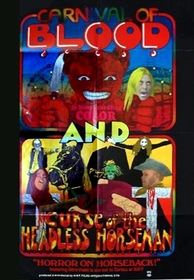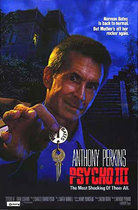Our editor-in-chief Nate Yapp is proud to have contributed to the new book Hidden Horror: A Celebration of 101 Underrated and Overlooked Fright Flicks, edited by Aaron Christensen. Another contributors include Anthony Timpone, B.J. Colangelo, Dave Alexander, Classic-Horror.com's own Robert C. Ring and John W. Bowen. Pick up a copy today from Amazon.com!
Carnival of Blood (1970)
Carnival of Blood is so beautifully original in composition and execution that it reminds you what an art form filmmaking is. This isn't to suggest that some films are not art or that most are not quality art. Rather, Carnival of Blood suggests what it does through pointing out the well-worn grooves of the filmmaking norm by not following most of them.
Cinema is, in many ways, still one of the more conservative art forms. Specific recipes for composing films are so firmly entrenched that they are inflated to a notion that those recipes are objective ones, necessary to create quality films. That is a mistaken notion. There are many ways, subtle or not, in which filmmakers could experiment with the established recipes; many different elements for which limited types of realization are usually taken for granted to be the only possible types of realization, and that, in truth, one could focus on for unusual permutations. Art forms such as painting, music and dance have followed this course of action in the past when they broke out from restricting molds and became diversely "poly-theoretic." It's time for films (at least films with decent distribution) to do the same thing en masse.
Carnival of Blood would make a good poster child for a successful attempt at relatively subtle mold breaking. It's not a surrealist work or an "experimental" work per se, but everything that it does, it does unusually and captivatingly.
The plot could be said to be about a psycho killer stalking Coney Island. It is about that to some extent, but it also focuses on a series of intriguing characters. The characters shift, though, and to a large degree, there aren't traditional protagonists and antagonists. For instance, Carnival of Blood begins with a young, bickering couple walking around Coney Island. He just wants to go home, and she wants to stay and experience everything; she can't understand why he's being such a fuddy-duddy. The couple occupies the opening before and during the titles. Suddenly, after the titles, we're treated to an incongruous episode in the life of an unrelated couple. Then we're brought back to the bickerers. As the movie progresses, however, the bickerers disappear and the couple featured in the incongruous episode become the focus, as does their neighbor. While that may not sound unusual in itself, the way director Leonard Kirtman executes the progression is unusual.
The dialogue throughout is brilliant, and somewhat like Pulp Fiction, which Carnival of Blood predates by many years, it lasts longer than typical movie dialogue while managing to be absorbingly realistic, "hyper-realistic" and campy at the same time. Although this is a horror film, it didn't have to be in order to capture your interest. Any of the dialogue scenes themselves could have been stretched into an entertaining two-hour film. In many ways, these scenes are the real stars of Carnival of Blood.
The art direction, lighting and cinematography produce a combination of brilliant, exaggerated, garish colors and a blatant stark atmosphere that almost outdoes George Romero. Although the special effects are low budget, the editing works wonders for them, and the gore scenes are both disturbing and beautiful in terms of art direction.
All performances are excellent, and like the dialogue (in fact, it's hard to say which is the causal factor here or whether they are coincident) they are realistic, hyper-realistic and campy at the same time. Some of the best performances come from the female bickerer in the opening, the whiney New Jersey-ite with the sunglasses, Earle Edgerton as Tom, and John Harris as Gimpy.
The score is great, and at various times ranges from somewhat traditional to ingeniously incongruous with the events unfolding onscreen. Carnival of Blood is even unusual in more fine details, such as the brilliantly bizarre chattering but soundless head of the lady bickerer in the corner of the title screens.
Recommendation: Carnival of Blood is an excellent example of a gritty 1970s horror/drama that stretches the envelope. Not only should fans of horror and gritty dramas enjoy it, but filmmakers should pay special attention to the unusual composition and pacing.








